ICSE Class 10 Biology Photosynthesis Questions and Answers
ICSE SolutionsSelina ICSE Solutions
APlusTopper.com provides ICSE Solutions for Class 10 Biology Chapter 5 Photosynthesis for ICSE Board Examinations. We provide step by step Solutions for ICSE Biology Class 10 Solutions Pdf. You can download the Class 10 Biology ICSE Textbook Solutions with Free PDF download option.
Download Formulae Handbook For ICSE Class 9 and 10
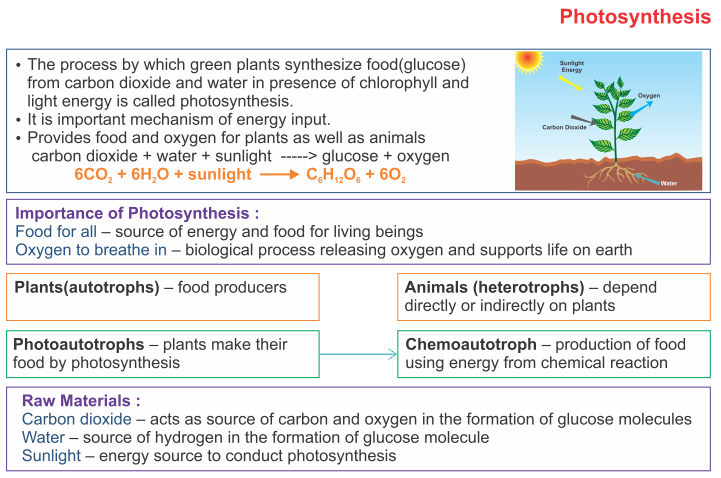
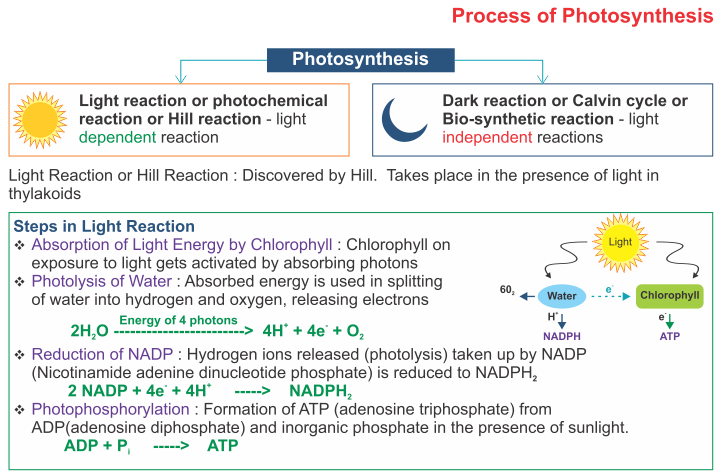
Short Questions
Question 1: What are the basic requirements of photosynthesis ?
Answer: The basic requirements of photosynthesis are:
- Solar energy from the sun.
- Green chlorophyll.
- Carbon dioxide from the air.
- Water.
Question 2: (i) Where are the chlorophyll pigments present in a cell.
(ii) Name the membrane that connects thylakoid of one granum With the other granum.
Answer: (i) In the cell organelle called plastids (or chloroplasts).
(ii) Stroma lamellae.
Question 3: Give some adaptations in a green leaf for photosynthesis.
Answer: (i) A large surface area to absorb water.
(ii) It is positioned at a right angle to the light to get maximum light.
(iii) There are numerous stomata to allow rapid exchange of gases.
(iv) Leaves are thin to allow rapid transport or diffusion of materials.
Question 4: What is the importance of photosynthesis in the life of the following :
(i) Green plants (ii) Non-green plants (iii) Animals
Answer: (i) Green plants are able to build up complex energy rich molecules of carbohydrates which are further used for different metabolic activities of cells.
(ii) Non-green plants such as saprophytes and parasites use the food prepared by green plants during photosynthesis as a source of their own nutrition.
(iii) Animals eat green plants or eat animals that feed on green plants.
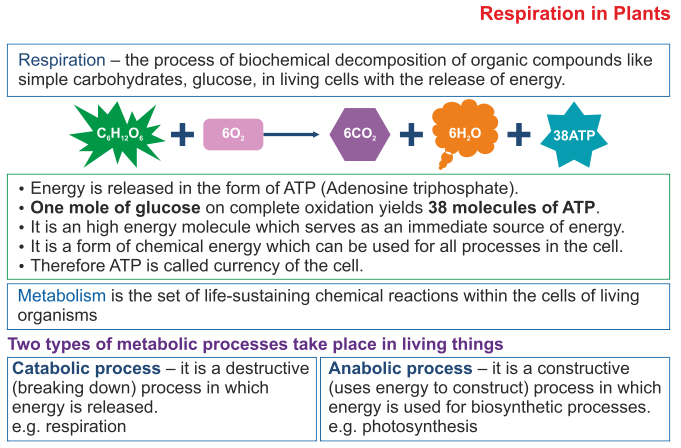
Question 5: A leaf is a food factory. Explain.
Answer: The leaves of green plants are specially developed for the purpose of synthesizing food. The leaf anatomy is best suited for collecting the raw materials. The leaf absorbs CO2 from the atmosphere through its stomatal openings. It gets water from the stem. The chloroplasts are the actual sites of photosynthetic reactions-light and dark reactions which result in the formation of glucose. Hence, the ability to collect raw materials and to carry on chemical reactions to synthesize food, it is called as the food factory of the plant.
Question 6: Why green leaves are thin and broad ?
Answer: Green leaves are thin and broad so that they can receive more light and can photosynthesize more efficiently.
Question 7: State one important function of chloroplasts.
Answer: Chloroplast contains chlorophyll which is used to trap the solar energy from the sunlight which falls on the leaf. This energy is used during photolysis to split the water molecule into hydrogen and oxygen.
Question 8: Which tissues and cells are mainly concerned with photosynthesis ?
Answer: The tissues and cells which contain chloroplasts are mainly the palisade parenchyma and spongy mesophyll cells of a green leaf.
Question 9: Why is photosynthesis important in nature ?
Answer: The body of all living organisms both plants and animals is dependent on the food that has been synthesized in a green cell by photosynthesis. The purification of the atmosphere whereby the volume of CO2 remains fairly constant due to the photosynthetic activity of green plants. Oxygen is given out by green plants.
Question 10: How do non-green plants such as fungi and bacteria obtain their nourishment ?
Answer: Non-green plants such as fungi and bacteria obtain their nourishment from decaying organic matter in their environment, which comes from dead animals and plants. Thus they are dependent on photosynthesis.
Question 11: “Oxygen is a waste product of photosynthesis.” Comment.
Answer: Oxygen liberated during photosynthesis is a waste for the plant, so, it is released into air and is used by living organisms in respiration.
Question 12: What is meant by photolysis of water ?
Answer: The splitting of water molecule into two component ions by light is known as photolysis of water.
(Photo = Light, lysis = Breaking).
H2 ———> H+ + OH–
Question 13: Oxygen given out during photosynthesis comes from water. Explain this statement.
Answer: During the process of photolysis under light reaction the water molecule split up to release H+ and OH– ions. These OH– react to liberate oxygen. Thus we can say that oxygen liberated during photosynthesis comes from water.
Question 14: How is the rate of photosynthesis affected when a green plant gets green light ?
Answer: The rate of photosynthesis decreases and finally stops when the green plant gets green light because green light is not absorbed but reflected back by the plant.
Question 15: Why is it not possible to demonstrate respiration in a green plant kept in the sunlight ?
Answer: When a plant is kept in sunlight, CO2 released by respiration gets used by photosynthesis to synthesize food. So no carbon dioxide is liberated, and respiration cannot be demonstrated.
Question 16: Explain why transpiration and photosynthesis are interlinked during the day.
Answer: During the day, the chloroplast in the guard cells are able to carry on photosynthesis, so the osmotic pressure in the cell sap of the guard cells is high and water enters the guard cells which lead to an opening of the stomatal aperture. Thus stomatal transpiration can take and CO2 can also enter the green leaf to enable photosynthesis to take place. So, during day time photosynthesis and stomatal transpiration occurs simultaneously.
Question 17: Explain, why respiration is said to be a reversed process of photosynthesis ?
Answer: In respiration, energy is released as a result of oxidation of food, whereas in photosynthesis it is stored up in a carbohydrate molecule. Oxygen is used in respiration whereas it is given out as a by-product in photosynthesis.
Question 18: Name the molecules which are called assimilatory power ? Why are they called so ?
Answer: ATP and NADPH2 are called assimilatory power. They are called so, because they provide the energy requirement for CO2 assimilation during dark reaction of photosynthesis.
Question 19: What is the law of limiting factor ?
Answer: Blackman (1905) established the law of limiting factor in connection with photo-synthesis. According to this law when a process is conditioned to its rapidity by a number of separate factors, the rate of process is limited by the pace of the lowest factor, i.e., the factor which is present in minimum amount.
Question 20: Complete the following food chains by writing the names of appropriate organisms in the blanks:

Answer: (i) Grasshopper, Hawk (ii) Grass, Insects, (iii) Rabbit, (iv) Com, Snake.
Question 21: On a bright sunny day water weeds growing in an aquarium were actively giving off bubbles of.gas. Use this information to answer questions that follow :
(i) Name the process occurring in the water weed that has resulted in evolution of these bubbles.
(ii) Of what gas do these bubbles consist ?
(iii) Briefly describe the reactions occurring in the leaves of the water weeds leading to the evolution of these bubbles.
(iv) Give an overall balanced chemical equation to represent the process named in (i) above.
Answer: (i) Photosynthesis.
(ii) Oxygen.
(iii) The process that takes place first in the photolysis of water is H+ and OH- ions with the help of energy from sunlight. The hydroxyl ions combine to form hydrogen peroxide 2OH —> H2O2 which decompose to give molecular oxygen, i.e.,
2H2O2 ——> 2H2O + O2
(iv)
![]()
Question 22: What is meant by destarched plant ? How can it be destarched ?
Answer: A destarched plant has no starch present in the leaves and a leaf remains yellowish-brown when tested with iodine during a starch test.
A plant can be destarched by keeping it in the dark for two or three days, so that the leaves are free from stored starch.
Question 23: Using the destarched plant describe step by step how would you proceed to prove that in the absence of light the leaf cannot manufacture starch ?
Answer: (i) In a dark room a leaf on the destarched plant is covered on either side with strips of black paper which is kept in place by paper clips or cellophane tape.
(ii) Now the potted plant is kept in light.
(iii) After a few hours, the leaf is detached from the plant and the black strips are removed.
(iv) Then the leaf is boiled in water for 2-3 minutes and then boiled in alcohol to remove the green chlorophyll.
(v) The leaf is then washed in water and tested with iodine.
(vi) The region of the leaf that was under the black strip turns yellowish-brown showing that no starch was made, while the rest of the leaf turns bluish-black showing the starch was made in the presence of light.
Question 24: A healthy croton plant bearing variegated leaves was kept in a dark cupboard to destarch it after which it was placed in sunlight for a few hours. One of the leaves was then plucked and an outline of the leaf marking the green and the non-green regions was drawn. The leaf was then tested for starch. Using the above information, answer the following questions :
(i) State the aim of the above experiment.
(ii) Name the chemical used for testing the presence of starch.
(iii) Why is the leaf boiled in water and alcohol before testing for the presence of starch ?
(iv) What change is seen on the leaf after the starch test ?
(v) Give the chemical equation to represent the process of starch formation in plants.
Answer: (i) Chlorophyll is necessary for photosynthesis.
(ii) Iodine solution.
(iii) Leaf is boiled in water to kill the cells and boiled in alcohol to remove chlorophyll.
(iv) The green parts of the leaf turned blue-black while non green parts turned brown.
(v)
![]()
Question 25: A candidate in order to study the importance of certain factors in photosynthesis took a potted plant and kept it in the dark for over 24 hours. Then in the early hours of the morning she covered one of the leaves with black paper in the centre only. She placed the potted plant in the sunlight for a few hours, and then tested the leaf which was covered with black paper for starch.
(i) What aspect of photosynthesis was being investigated ?
(ii) Is there any control in this experiment ? If so, state the same.
(iii) Why was the plant kept in the dark before the experiment ?
(iv) Describe step by step how the candidate proceeded to test the leaf for the presence of starch.
Answer: (i) The student is investigating the necessity of sunlight for photosynthesis.
(ii) The leaf portion which is not covered with black paper is the control as it receives sunlight.
(iii) The plant is kept in the dark before the experiment to destarch the leaves.
(iv) The leaf is tested for presence of starch as follows:
- The leaf is boiled with alcohol over a water bath till it becomes colourless.
- It is rinsed with hot water to remove alcohol and spread it on a white tile.
- Pour iodine solution on it. The portion covered with black paper remains colourless while rest of the leaf turn blue black.
Question 26: A potted plant was taken in order to prove a factor necessary for photosynthesis. The potted plant was kept in the dark for 24 hours. One of the leaves was covered with black paper in the centre. The potted plant was then placed in sunlight for a few hours.
(i) What aspect of photosynthesis was being tested ?
(ii) Why was the plant placed in the dark before beginning the experiment ?
(iii) During the starch test why was the leaf:
(1) boiled in water
(2) boiled in methylated spirit.
(iv) Write a balanced chemical equation to represent the process of photosynthesis.
Answer: (i) That light is necessary for photosynthesis.
(ii) To remove all starch from the leaves of the plant.
(iii) (1) To kill the cells.
(2) To destroy the chlorophyll.
(iv)
![]()
Question 27: Write an experiment to demonstrate that CO2 is necessary for photosynthesis.
Answer: Take a destarched plant. Insert one of its leaves in a conical flask, which contains potassium hydroxide. Leave it in the sunlight. After a few hours, test this and any other leaf of this plant for starch. The leaf which was exposed to the atmospheric air becomes blue black, and the one in the flask containing KOH does not become blue black after iodine test. The experiment showing that CO2 is necessary for photosynthesis.
Question 28: List the events taking place in the photo-chemical phase of Photosynthesis.
Answer: Photochemical phase of photosynthesis is light dependent. A series of chemical reactions occur in quick succession initiated by light, therefore the phase is called photochemical phase. It takes place in chlorophyll containing thylakoids of chloroplast.
It occurs in following steps :
- The chlorophyll on exposure to light energy becomes activated by absorbing photons.
- This energy is used in splitting the water molecules (photolysis) as below :-
H2O ——> H+ + OH– - OH– ions through a series of steps produce water (H2O) and oxygen (O2). Water may be used inside the plant but O2 released into the atmosphere.
- H+ combines with CO2 in dark reaction to produce glucose.
Question 29: If you are planning an experiment to show the effect of light on photosynthesis :
(1) Will you select white light or green light ? Justify your answer.
(2) Why would you select a destarched plant ?
Answer: (1) I will select white light because photosynthesis is maximum in white light while it is minimum in green light as green light is reflected by green plants.
(2) I will select destarched plant so I Can demonstrate the synthesis of starch through iodine test.
Give Reasons
Question 1: All life on earth Would come to an end if there were no green plants.
Answer: Green plants manufacture food during the process of photosynthesis and give out oxygen a life supporting gas for all organisms.
Question 2: Photosynthesis is considered as a process supporting all life on earth.
Answer: This process produces food and releases oxygen, both of which are necessary to maintain life on earth.
Question 3: Chlorophyll is necessary for photosynthesis.
Answer: The chlorophyll traps solar energy and converts it into chemical energy.
Question 4: Chloroplasts are called energy converters.
Answer: The chlorophyll traps solar energy and converts it into chemical energy.
Question 5: ATP is needed for dark reaction.
Answer: ATP provides energy for dark reaction.
Question 6: Respiration is said to be the reversal of photosynthesis.
Answer: Respiration is a catabolic process while photosynthesis is an anabolic process. During respiration CO2 is given out while during photosynthesis O2 is given out.
Differentiate
Question 1: Light reaction and Dark reaction.
Answer:
| Light Reaction | Dark Reaction |
| (i) It fakes place in the presence of light. | It does not require light. |
| (ii) It occurs in the grana of chloroplast. | It occurs in the stroma of chloroplast. |
| (iii) Its products are ATP and NADPH2. | Its products are organic compounds. |
Question 2: Stroma of chloroplast and Grana of chloroplast.
Answer:
| Stroma of Chloroplast | Grana of Chloroplast |
| (i) It is the site of dark reaction. | It is the site of light reaction. |
| (ii) It is a non-green granular matrix. | It is green flattened sac like structure. |
Question 3: Chloroplast and Chlorophyll.
Answer:
| Chloroplast | Chlorophyll |
| (i) It is an organelle of the cell. | It is the green pigment in chloroplast. |
| (ii) It is living. | It is non-living. |
Question 4: Autotrophs and Heterotrophs.
Answer:
| Autotrophs | Heterotrophs |
| (i) They can produce their own food. | They cannot prepare their own food. |
| (ii) They contain chlorophyll. | Do not contain chlorophyll. |
Diagram Based Questions
Question 1: The figure below represents the vertical section of a leaf:

(i) Name the parts 1 to 5.
(ii) How many veins have been shown.
(iii) State the functions of part 4 and 5.
Answer: (i) 1. Cuticle
2. Upper Epidermis
3. Palisade tissue/chioroplast
4. Xylem
5. Stomata
(ii) One vein has been shown.
(iii) Xylem – helps in the conduction of water.
Stomata – through which exchange of gases takes place.
Question 2:

(i) Identify the above diagram.
(ii) Label the guidelines 1-3.
(iii) Name the phenomenon which takes place in the above diagram.
(iv) Define the phenomenon.
(v) What is the importance of the above phenomenon ?
Answer: (i) Chloroplast.
(ii) 1. Granum
2. Stroma.
3. Thylakoids.
(iii) Photosynthesis.
(iv) Photosynthesis is the process by which living plant cells, containing chlorophyll, produce food substances (glucose and starch), from carbon dioxide and water, by using light energy. Plants release oxygen as a waste product during photosynthesis.
(v) Photosynthesis is the source of energy food and oxygen.
Question 3: The figure given below represents an experiment to demonstrate a particular aspect of photosynthesis. The alphabet ‘A’ represents a certain condition inside the flask.
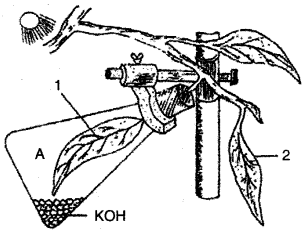
(i) What is the aim of the experiment ?
(ii) Identify the special condition inside the flask.
(iii) Name an alternative chemical that can be used instead of KOH.
(iv) In what manner do the leaves 1 and 2 differ at the end of the starch test ?
Answer: (i) To prove that CO2 is necessary for photosynthesis.
(ii) No CO2 in the flask.
(iii) CaO (limestone), potassium pyrogollate.
(iv) Leaf 1, no change in colour with starch list.
Leaf 2, will turn blue black at the end of starch test.
Question 4: The figure below represents an experiment performed to demonstrate a particular aspect of photosynthesis. The apparatus was kept in sunlight for almost the whole day. The numeral ‘1’ represents a certain condition inside the flask and the numeral ‘2’ represents a chemical responsible for this condition.
(i) What is the object of the experiment ?
(ii) What is the special condition inside the flask ?
(iii) What is the chemical substance numbered ‘2’?
(iv) In what way will the three leaves (A, B and C) differ at the end of the experiment, when tested with iodine solution?
Answer: (i) The object of this experiment is to show that CO2 is necessary for photosynthesis.
(ii) The special condition inside the flask is that there is no CO2 in the air as it has been absorbed by the KOH.
(iii) KOH or NaOH pellets.
(iv) Leaf A will be yellowish-white. Leaf B and Leaf C will turn blue-black.
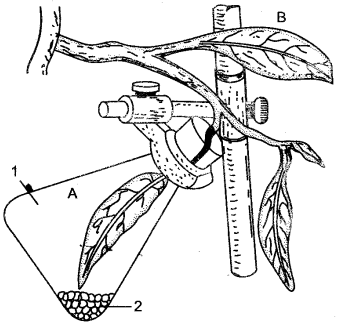
Question 5: The figure below represents an experiment set up to study a physiological process in plants:

(i) Name the physiological process being studied.
(ii) Explain the process.
(iii) What is the aim of the experiment?
(iv) Give a well balanced equation to represent the process.
Answer: (i) Photosynthesis.
(ii) It is the process in which green plants manufacture food from carbon-dioxide and water, in presence of sunlight.
(iii) To show that oxygen is given out during photosynthesis.

Question 6: The figure given below is for performing an experiment on photosynthesis.
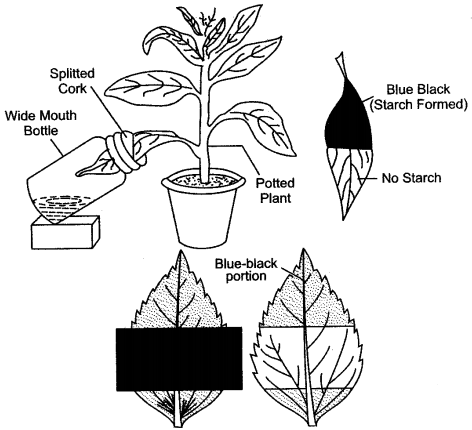
Answer the following:
(i) What is the aim of this experiment?
(ii) Describe an experiment to show that light is necessary for photosynthesis.
(iii) What do you conclude from this experiment?
(iv) What is the role of light in photosynthesis?
Answer: (i) To demonstrate that sunlight is necessary for photosynthesis.
(ii) Take a potted plant and keep it for 2-3 days in dark to destarch its leaves. Take one leaf and cover it on both sides with two black paper strips, as shown in the diagram, with the help of cellophane tape. Now keep the potted plant in light. After a few hours pluck the leaf and remove the black strips. Boil the leaf in alcohol and wash in water. Test the leaf for starch with iodine solution. The leaf turns blue all over except the region covered with black strips. This shows that the region which did not receive light could not synthesise starch. Thus, light is necessary for photosynthesis.
(iii) Light is necessary for photosynthesis.
(iv) Light supplies eiergy in the form of photons to split water during tight reaction.
Question 7: A well watered healthy potted plant with variegated leaves was kept in darkness for about 24 hours. It was then set up as shown in the diagram and exposed to light for about 12 hours. At the end of this time leaf X and leaf Y were tested for starch. Study the diagram and answer the questions that follow:
(i) Why was the plant initially kept in darkness for 24 hours?
(ii) What is the function of sodium hydroxide solution in the flask?
(iii) Select the correct leaf from the five available choices shown in the diagram as A, B, C, D and E. Rewrite the correct answer for the filling in the appropriate letter from the questions that follow:
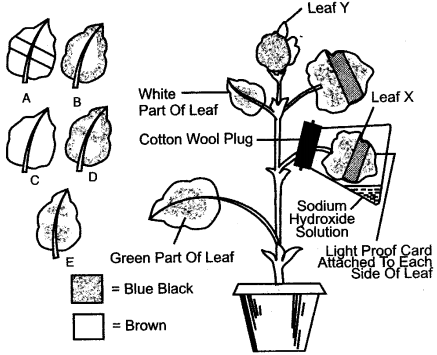
1. After the starch test, leaf X would look like.
2. After the starch test, leaf Y would look like.
Answer: Answer has not given due to out of present syllabus.
Question 8: Select the correct answer out of the available choices given under each question.
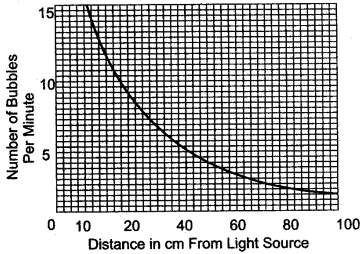
(i) From the graph it seems likely that the rate of bubbling per minute at 50 cm., would have been :
(a) 2-0 (b) 2-5 (c) 3-0 (d) 3-5 (e) 4-0
(ii) The gas produced by the plant during the experiment was :
(a) Air (b) Oxygen (c) Carbon dioxide (d) Nitrogen (e) Hydrogen
(iii) The gas collected comes due to the breakdown of:
(a) Glucose (b) Starch (c) Water (d) Air (e) ATP
(iv) If ice cubes were added to the water, the rate of bubble formation would :
(a) Remain the same.
(b) Increase because more water is added.
(c) Decreases because the temperature drops.
(d) Decreases because water freezes.
(e) Cannot tell from the information given.
(v) If some sodium bicarbonate is added to the water the rate of bubble formation:
(a) Increases because more respiration occurs.
(b) Increases because more photosynthesis occurs.
(c) Increases because the gas becotne less soluble.
(d) Decreases because carbon dioxide acts as a limiting factor.
(e) Decreases because respiration decreases.
Answer: (i) 3-5, (ii) Oxygen, (iii) Water, (iv) Decreases because the temperature drops, (v) Increases because photosynthesis increases.
Question 9: (i) Draw a neat and well-labelled diagram of the Chloroplast.
(ii) List the events taking place in the photo-chemical phase of Photosynthesis.
(iii) If you are planning an experiment to show the effect of light on photosynthesis :
(a) Will you select white light or green light ? Justify your answer.
(b) Why would you select a destarched plant ?
Answer: (i)

(ii) Photo chemical phase of photosynthesis is light dependent. A series of chemical reactions occur is quick succession initiated by light, therefore the phase is called photochemical phase. It takes place is chlorophyll containing thylakoids of chloroplast.
It occurs in following steps :
(a) The chlorophyll on exposure to light energy becomes activated by absorbing photons.
(b) This energy is used in splitting the water molecules (photolysis) as below :
H2O —-> H+ + OH–
(c) OH– ions through a series of steps produce water (H2O) and oxygen (O2). Water may be used inside the plant but O2 released into the atmosphere.
(d) H+ combines with CO2 in dark reaction to produce glucose.
(iii) (a) I will select white light because photosynthesis is maximum in white light while it is minimum in green light as green light is reflected by green plants.
(b) I will select destarched plant so I can demonstrate the synthesis of starch through iodine test.
Sketch and Label the Diagram
Question 1: Draw a neat and well-labeled diagram of the Chloroplast.
Answer:
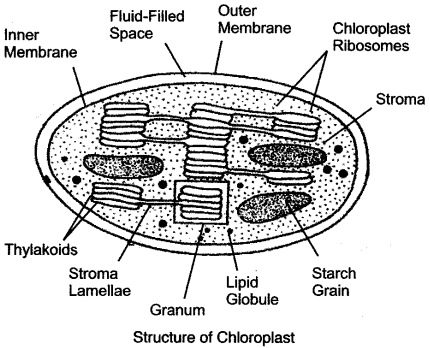
Question 2: Draw a neat and well-labeled diagram of the apparatus you would set up to show that oxygen is given out during photosynthesis.
Answer: See figure.
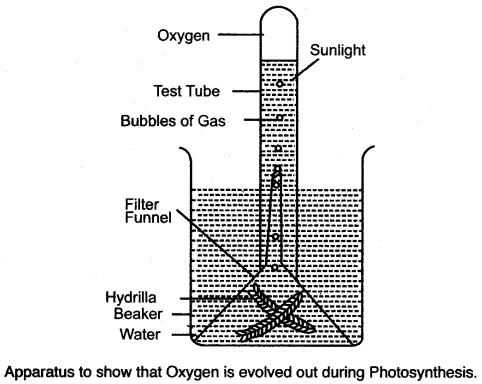
Explain the Terms
Question:
1. ATP
2. Calvin Cycle
3. Free Energy
4. NADPH
5. Plastoquinone
6. Photosynthesis
7. Photosynthetic Membrane
8. Phosphorylation
9. NADP
10. Photophosphorylation
11. Carbon cycle.
Answer: 1. ATP: Adenosine triphosphate, a small water soluble molecule that acts as an energy currency in cells.
2. Calvin Cycle: The biochemical reactions, initiated by Rubisco, that result in the reduction of CO2 to a carbohydrate (also known as the photosynthetic carbon reduction cycle).
3. Free Energy: The amount of energy in a reactions available to do work. Because most biochemical reactions occur at a constant temperature and pressure.
4. NADPH: Reduced form of nicotinamide ademne dinucleotide phosphate, a small water soluble molecule that acts as a hydrogen carrier in biochemical reactions.
5. Plastoquinone: A small molecule involved in electron and proton transfer in photosynthesis.
6. Photosynthesis: The physical-chemical process by which certain chlorophyll (containing organisms use light energy for the biosynthesis of organic molecules.
7. Photosynthetic Membrane: A bilayer of lipid molecules in which are embedded proteins that transform light’energy into chemical free energy. (Also known as the thylakoid membrane.)
8. Phosphorylation: The covalent attachment of a phosphate group to a molecule.
9. NADP (Nicotinamide Adenine dinucleotide phosphate): It is a coenzyme. During election transfer NADP get reduced and (rom NADP + H (NADPH2).
10. Formation of ATP in the chioroplast in the presence of light is called photophosphorylation.
11. The various processes resulting in the circulation of carbon in different forms constitute the carbon cycle.
Name the Following
Question:
1. The process by which plants produce their food.
2. The green colouring matter of the plants.
3. The principal site in a green leaf for photosynthesis.
4. Source of oxygen given out in photosynthesis.
5. The site of light reaction in the cell of a leaf.
6. Light in which maximum rate of photosynthesis takes place.
7. A high energy reduced compound formed in the light reaction and enter into the dark reaction.
8. The immediate product of photosynthesis.
9. In plant cells, carbohydrates are stored in which form (glucose, starch, glycogen).
10. The chemical substance used to test the presence of starch in the cell of a leaf.
Answer:
1. Photosynthesis
2. Chlorophyll
3. Chloroplast
4. Water
5. Grana
6. Red
7. NADPH2
8. Glucose
9. Starch
10. Iodine
Give Technical Terms
Question:
1. Name the process which is responsible for conversion of solar energy to chemical energy that is essential to sustain the life on this earth ?
2. Name the structure where photophosphorylation takes place.
3. Form of energy which is converted into chemical energy during photosynthesis.
4. In photosynthesis radiant energy is converted into which from ?
5. What is the percentage of CO2 in air ?
6. Organisms which cannot prepare their own food by photosynthesis.
7. The main reaction which means the breaking up of water molecules through light.
8. Which process is the ultimate source of energy for all living organisms ?
9. Name only one plant, you are familiar with which has no chlorophyll.
10. Name the tissue that transports manufactured starch from the leaves to all parts of the plant.
11. What does ATP abbreviated for ?
12. What does NADP stand for ?
13. The part of the chloroplast where the dark reaction of photosynthesis takes place.
14. Name the experiment to demonstrate the importance of light for photosynthesis.
Answer:
1. Photosynthesis
2. Chloroplast
3. Radiant energy
4. Chemical energy
5. 0.03-0.04%
6. Heterotrophs
7. Photolysis
8. Photosynthesis
9. Mushroom
10. Phloem
11. Adenosine Triphosphate
12. Nicotinamide Adenine Dinucleotide Phosphate
13. Stroma
14. Light screen experiment
Fill in the Blanks
Complete the following sentences with appropriate words :
1. A light induced reaction which leads to splitting of water is Photolysis of water.
2. A plant that does not perform photosynthesis is Fungus.
3. One of the product of Photolysis of water is oxygen.
4. Chloroplasts are regarded as complete photosynthetic units of plants.
5. AIIP stands for Adenosine diphosphate.
6. 230-250 molecules of chlorophyll make one quantasome.
7. Carbon dioxide enters the leaf through Stomata.
8. Xanthophyll is Yellow coloured pigment.
9. The conversion of physical energy of light into chemical energy by the chloroplast is called Photophosphorylation.
10. Calvin cycle was proposed by Melvin Calvin.
11. A dark reaction is a Thermochemical reaction.
12. A light reaction is a Photochemical reaction.
13. 4OH ——> 2H2O + O2
True & False
Mention, if the following statements are True or False. If false rewrite the wrong statement in its correct form:
1. Photosynthesis occurs only in plants. (False, Photosynthesis occurs in all green plants.)
2. Too much light destroys chlorophyll. (True)
3. The unit of light absorbed by the chlorophyll during photosynthesis is the proton. (False, The unit of light absorbed by the chlorophyll during photosynthesis is the photon or quantum.)
4. The process of photosynthesis takes place in the dark. (False, It takes place in the presence of sunlight.)
5. CO2 is the life supporting gas produced due to photosynthesis. (False, Oxygen is the life supporting gas produced due to photosynthesis.)
6. PhotoLysis is the reaction which means the breaking up of water molecules. (True)
7. Radiant energy is converted into chemical energy by photosynthesis. (True)
8. Leaves are broad and flat to increase the surface area for photosynthesis. (True)
9. The raw materials for photosynthesis include water and CO2. (True)
10. Photosynthesis results in loss of dry weight of the plant. (False, Photosynthesis results in gain of dry weight of the plant.)
11. Land plants obtain their CO2 from atmosphere. (True)
12. Photosynthesis occurs in all the cells of a plant. (False, Respiration occurs in all the cells of a plant.)
13. No transpiration occurs during photosynthesis. (False, Transpiration occurs along with photosynthesis.)
14. A variegated leaf (one that has green as well as white patches) will only photosynthesize in the green areas. (True)
15. The dark reaction of Photosynthesis is light independent. (True)
16. All the starch produced in a leaf remains stored in it for 2-3 weeks before it is used by other parts of plant. (False, It remains stored in it for 24 to 48 hours)
17. Photosynthesis can also occur n artifidal light such as that of a 100 watt electric lamp. (True)
18. KOH absorbs CO2. (True)
19. Out of nine types of chlorophyll, chlorophyll ‘a’ and ‘b’ are most abundant. (True)
State the Location
| Name | Location |
| Thylakoid | Each granum of the chloroplast. |
| Stomata | Lower surface of leaf. |
| Chlorophyll | Walls of thylakoids. |
| Stroma | Inner portion of chloroplast. |
State the Function
Write the functional activity of the following structures:
| Name | Function |
| Granum | Light reaction of photosynthesis. |
| Stroma | Dark reaction of photosynthesis. |
| Chloroplasts | Photosynthesis. |
| Thylakoids | Help in photosynthesis. |
Choose the Odd One Out
1. Grana, Thylakoid, Stroma, Root. (Root)
2. Chlorophyll, Chlorophyll b, n-carotene, Photon. (Photon)
3. Glucose, Water, Oxygen, Carbon-dioxide. (Carbon-di-oxide)
4. Light intensity, Water content, Temperature, Chlorophyll. (Chlorophyll)
Multiple Choice Questions
1. Chlorophyll is present:
(a) In the grana of chloroplast (b) On the surface of chloroplast
(c) Dispersed throughout the chloroplast (d) In the stroma of chloroplast
2. The specific function of light energy in the process of photosynthesis is to:
(a) Reduce.carbon dioxide (b) Synthesize glucose
(c) Activate chlorophyll (d) Split water
3. Which one of the following would not be a limiting factor for photosynthesis ?
(a) Oxygen (b) Light
(c) Carbon dioxide (d) Chlorophyll
4. A cell that lacks chioroplast does not:
(a) Evolve carbon dioxide (b) Liberate oxygen
(c) Require water (d) Utilize carbohydrates
5. Which would do maximum harm to a tree?
(a) Loss of half of its branches (b) Loss of half of its flowers
(c) Loss of all of its leaves (d) Loss of a little bark
6. NADP is expanded as:
(a) Nicotinamide, adenosine dinucleotide phosphate
(b) Nicotinamide, adenine dinucleotide phosphate
(c) Nicotinamide, adenine dinucleous phosphate
(d) Nicotinamide, adenosine dinudeous phosphate
7. A plant is kept in a dark cupboard for about 48 hours before conducting any experiment on photosynthesis to:
(a) Remove starch from the plant
(b) Ensure that starch is not translocated from the leaves
(c) Remove chlorophyll from the leaf of the plant
(d) Remove starch from the experimental leaf
8. The main difference between chlorophyll ‘a’ and ‘b’ is:
(a) Chlorophyll ‘a’ is a linear chain compound and ‘b’ is branched chain
(b) Chlorophyll ‘a’ has no Mg ion in centre of molecule
(c) In chlorophyll ‘a’ there is — CH3 group whereas in ‘b’ it is — CHO group
(d) All of the above
9. Compensation point means the condition:
(a) When the entire food manufactured in photosynthesis remains unutilised
(b) When the pot is watered just to meet the full requirement of the plant
(c) When rate of photosynthesis is equal to rate of respiration
(d) Where there is neither photosynthesis nor respiration.
Match the Column
Column ‘II’ is a list of items related to ideas in Column ‘I’. Match the term in Column ‘II’ with the suitable idea given in Column ‘I’.
| Column I | Column II |
| (i) Grana | (a) Decomposers |
| (ii) Autotrophs | (b) Light reaction |
| (iii) By-products of photosynthesis | (c) Animals |
| (iv) Photolysis | (d) Oxygen |
| (v) Bacteria and fungi | (e) Stimulated by light |
| (vi) Chloroplast | (f) Power |
| (vii) Oxygen and water | (g) Raw material |
| (viii) Sunlight | (h) Machinery |
| (ix) CO2 and water | (i) End products |
| (x) Glucose (sugar) | (j) Workrooms |
| (xi) Cells in the leaf | (k) By-products. |
Answer: (i) (f) (ii) (d) (iii) (e) (iv) (b) (v) (a) (vi) (c) (vii) (f) (viii) (a) (ix) (b) (x) (d) (xi) (e)
ICSE Solutions for Class 10 Biology
- Cell Division Class 10 ICSE Questions and Answers
- Fundamentals of Genetics Class 10 ICSE Questions and Answers
- Absorption by Roots Class 10 ICSE Questions and Answers
- Transpiration Class 10 ICSE Questions and Answers
- Photosynthesis Class 10 ICSE Questions and Answers
- The Circulatory System Class 10 ICSE Questions and Answers
- The Excretory System Class 10 ICSE Questions and Answers
- The Nervous System and Sense Organs Class 10 ICSE Questions and Answers
- The Endocrine System Class 10 ICSE Questions and Answers
- The Reproductive System Class 10 ICSE Questions and Answers
- Human Population Class 10 ICSE Questions and Answers
- Physical Health and Hygiene Class 10 ICSE Questions and Answers
- Pollution Class 10 ICSE Questions and Answers
